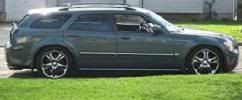variable intake
Hey guys, maybe I can chime in on the variable intake manifold thing a bit.
The main purpose of a manifold with variable length intake runners (which the 3.9L has) is to capture stronger (i.e. lower harmonic#) pressure waves for an increased tuning effect which improves volumetric efficiency (torque up). the pressue waves which bounce back and forth btw the valve and plenum travel at the speed of sound. this remains constant. you want a high pressure wave to arrive at the valve just before it closes. however, as engine speed increases, the actual time between each intake event decreases. For example, if you have a runner length tuned/designed to capture a wave at 2500rpm, you can see that the wave will be late at say 3000rpm. The degree to which this happens depends on the runner length and the cam timing. Eventually, at a higher rpm you will pick that same wave back up again, however, it will have traveled the distance of the runner 2 more times and been reflected 2 additional times, reducing its strength and effect. This is where a variable runner comes in. By switching to a shorter runner at higher RPM, you are now catching a pressure pulse that hasnt been reflected as many times. These pressure waves are constantly traveling back and forth in the runner until they become so weak they have no effect and are no longer measureable. A new wave goes out every time your valve closes, it comes from the actual vibration/sound of the valve closing on the seat. I tried to make that as clear as possible, but it is hard to explain without writing an entire page. Anyways, getting to my point. I dont think a variable intake would effect a turbo's boost very much. A turbo's boost (among other obvious things) is dependent on the amount of exhaust gases flowing through the turbine...which is proportional to engine RPM. The intake isnt going to have a large effect on turbo rpms...engine speed and your right foot have a much greater effect.
My main concern with the variable intake manifold would be whether or not the switching mechanisms' various seals could withstand the boost pressure of a turbo without completely blowing or at least leaking to the runner portions not in use. There is a possibility it could be a non-issue depending on the design, but you'd have to see the inside of the manifold to determine that.
Respectfully,
Anthony
Hey guys, maybe I can chime in on the variable intake manifold thing a bit.
The main purpose of a manifold with variable length intake runners (which the 3.9L has) is to capture stronger (i.e. lower harmonic#) pressure waves for an increased tuning effect which improves volumetric efficiency (torque up). the pressue waves which bounce back and forth btw the valve and plenum travel at the speed of sound. this remains constant. you want a high pressure wave to arrive at the valve just before it closes. however, as engine speed increases, the actual time between each intake event decreases. For example, if you have a runner length tuned/designed to capture a wave at 2500rpm, you can see that the wave will be late at say 3000rpm. The degree to which this happens depends on the runner length and the cam timing. Eventually, at a higher rpm you will pick that same wave back up again, however, it will have traveled the distance of the runner 2 more times and been reflected 2 additional times, reducing its strength and effect. This is where a variable runner comes in. By switching to a shorter runner at higher RPM, you are now catching a pressure pulse that hasnt been reflected as many times. These pressure waves are constantly traveling back and forth in the runner until they become so weak they have no effect and are no longer measureable. A new wave goes out every time your valve closes, it comes from the actual vibration/sound of the valve closing on the seat. I tried to make that as clear as possible, but it is hard to explain without writing an entire page. Anyways, getting to my point. I dont think a variable intake would effect a turbo's boost very much. A turbo's boost (among other obvious things) is dependent on the amount of exhaust gases flowing through the turbine...which is proportional to engine RPM. The intake isnt going to have a large effect on turbo rpms...engine speed and your right foot have a much greater effect.
My main concern with the variable intake manifold would be whether or not the switching mechanisms' various seals could withstand the boost pressure of a turbo without completely blowing or at least leaking to the runner portions not in use. There is a possibility it could be a non-issue depending on the design, but you'd have to see the inside of the manifold to determine that.
Respectfully,
Anthony







Comment